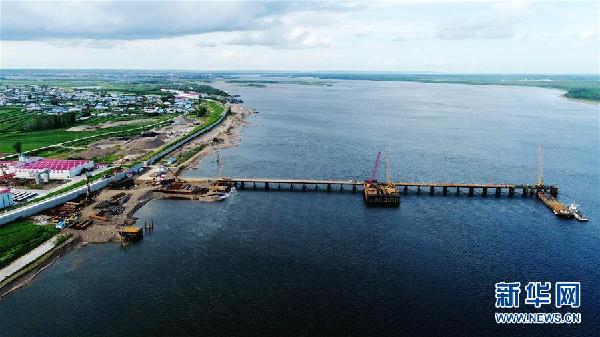
Scenery in northeast China's Heilongjiang Province (Xinhua file photo)
HARBIN, Oct. 7 (Xinhua) -- "I am so happy to see the smooth construction of the first China-Russia cross-border road bridge," said Nagia after she and another 120 artists from China and Russia performed at the bridge construction site.
Construction of the long-awaited bridge across the Heilongjiang River, or the Amur River in Russia, started in 2016 after 28 years of negotiation between China and Russia.
The bridge and its corresponding infrastructure are important parts of the China-Mongolia-Russia economic corridor under China's Belt and Road Initiative, intended to trigger a development boom in the region.
In 2013, China introduced the Belt and Road Initiative connecting the vibrant Asian economic circle at one end and Europe at the other, and then extending it further to other regions.
China's rust belt covers Liaoning, Jilin and Heilongjiang provinces in the northeast, which border Russia and are located in the center of Northeast Asia.
It was among the first regions in China to become industrialized. Traditional industries include steel, automobiles, shipbuilding, aircraft manufacturing, and petroleum refining.
The provinces saw double-digit economic growth until 2012 and 2013, when the region faced shrinking resources and industrial overcapacity amid the global economic slowdown.
In 2015, economic growth in the three provinces trailed behind the national average, with Heilongjiang, Jilin, and Liaoning posting growth of 5.7 percent, 6.5 percent and 3 percent, respectively. The 3-percent growth rate in Liaoning was the lowest of all 31 provincial regions.
After the Belt and Road Initiative was proposed, China's rust belt worked to improve cross-border transport facilities and develop export-oriented industries to rejuvenate the region's economy by taking advantage of its favorable location.
In September, China's first international cold chain logistics cargo train left Qiqihar City in Heilongjiang for Moscow of Russia.
The train mainly carries fruit, vegetable and frozen food produced in the northeast to Russia, and then returns with Russian dairy products to China, said Dong Ling, chairman of Heilongjiang Longyun Group.
China-Europe cargo trains have transported many affordable high-quality goods to China, said Liu Hanzhong, a staff member at a supermarket in Changchun City, capital of Jilin Province.
As a traditional industrial base, China's rust belt has also encouraged local companies to go global.
Chinese automaker FAW Group, established in 1953 in Changchun, set up an overseas investment company in September with five Chinese firms to accelerate its expansion in countries along the Belt and Road.
FAW will continue to improve its auto sales and financial loan service in countries along the Belt and Road to bolster its industrial chain, said Qiu Xiandong, deputy general manager of FAW Group.
Additionally, Jilin Province has set up a cooperation relationship with local governments from 83 countries and regions and 382 multi-national companies under its plan to expand international markets.
Opening up and cooperation are the only way to power the region's rejuvenation, said Lin Nianxiu, deputy head of China's National Development and Reform Commission.

